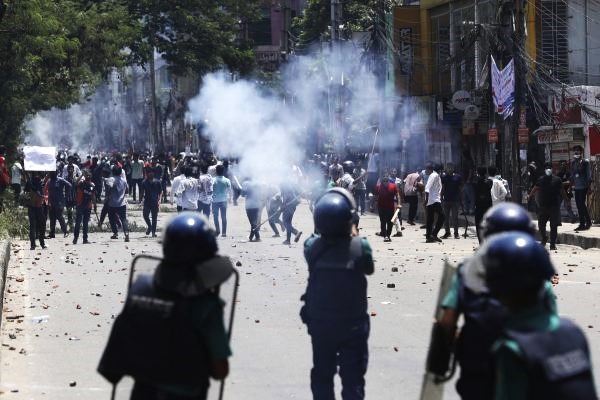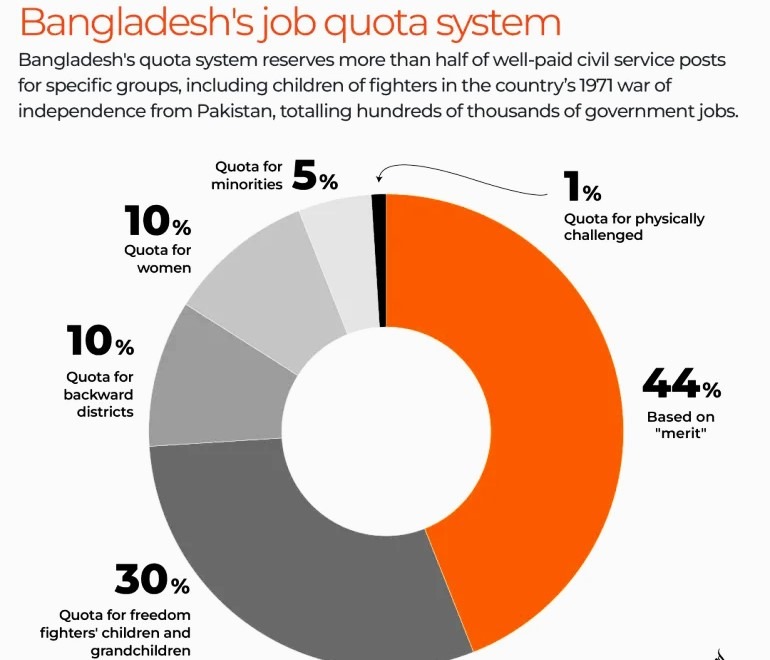The ongoing clashes between students and the security forces over a quota system have left at least 50 people dead and hundreds injured. The country’s internet has been suspended and all the news broadcasts shut down. Furthermore, a telecommunications blackout has cut off Bangladesh from the rest of the world. The entire country is plunged into the chaos of military curfew.
What this unrest is all about. It stems from a Deep-seated angle over a quota system that reserves 56% of the government jobs for certain groups including 30% for the descendants of the 1971 Freedom Fighters. people are demanding a complete overhaul of the system out rightly rejecting Prime Minister Sheikh Hasina whom they now label a dictator for her government’s brutal track down on the protesters. As many are calling it early this week Hasina had shot all universities and colleges the epicenters of the protest indefinitely. on Wednesday Hasina gave a speech denouncing the deaths of students killed in the protest and all of the protesters to wait until the high Court’s final order.
on the other hand, Hasina’s government had scrapped the quota system in 2018, but a court reinstated it last month. The Supreme Court suspended the decision after a government appeal and will hear the case on Sunday after agreeing to bring forward a hearing scheduled for Aug. 7.

On Saturday, Soldiers patrolled the deserted streets of the Bangladesh capital Dhaka and the government ordered all offices and institutions to stay closed for two days after at least 114 people were killed this week during student-led protests against government job quotas.
At least four people died, during sporadic clashes on Saturday in some areas of Dhaka, which has been the center of the protests, and where security forces set up roadblocks to enforce a curfew.
Meanwhile, Prime Minister Sheikh Hasina’s government declared Sunday and Monday as “public holidays” due to the situation in the country, Authorities had earlier closed universities and colleges from Wednesday.
The demonstrations were the biggest since Hasina was re-elected for a fourth successive term this year.The clashes have injured thousands, according to hospitals across Bangladesh. The Dhaka Medical College Hospital received 27 dead bodies on Friday. During the week police fired tear gas, rubber bullets and hurled sound grenades to scatter protesters throwing bricks and setting fire to vehicles.With the death toll climbing and police and other security forces unable to contain the protests, authorities imposed a national curfew and deployed the military, who were given orders to shoot on sight if needed.
Apart from this, it has done little to quell the situation as per reports the sound of tear gas gunfire and flash grenades echoed in areas close to the universities in the country’s capital Dhaka. there have been reports of violence in 47 of Bangladesh’s 64 districts.
The curfew was eased for two hours from noon on Saturday to allow people to shop for supplies and complete other chores. It will last until 10 a.m. on Sunday when the government will assess the situation. Those venturing out had their identification cards inspected by army personnel at checkpoints. The troops had set up roadblocks and bunkers using sandbags across strategic locations of Dhaka. In Bangladesh’s central district of Narsingdi, protesters stormed a prison on Friday, freeing more than 850 inmates and setting fire to the facility, with scattered incidents of arson reported in parts of the country on Saturday.
